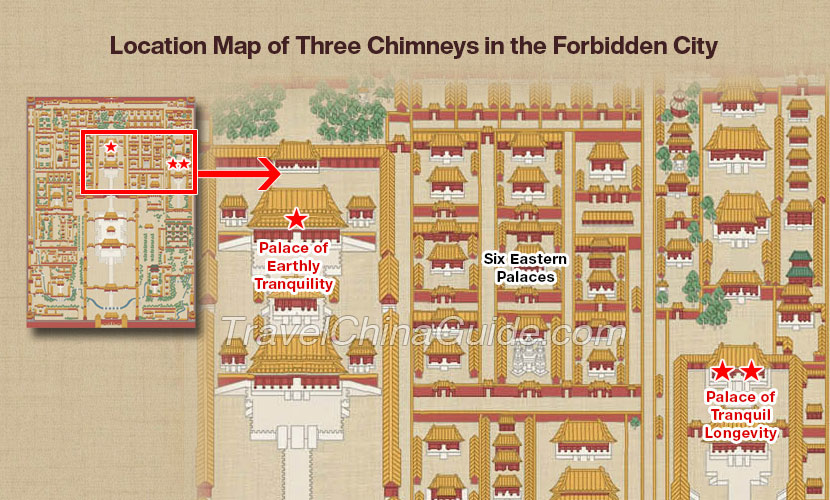Three Chimneys in the Forbidden City
There are three chimneys in the Forbidden City, one in the Palace of Earthly Tranquility (Kunninggong) and two in the Palace of Tranquil Longevity (Ningshougong). They are attached to the big hearths for sacrificial use in the Qing Dynasty (1636 - 1912). These chimneys were set outside the palace hall with bricks, high in square shape and hollow inside. On top of them, are small bronze “palaces”, which are the outlet flues of the chimneys.
There is no chimney in the Forbidden City such as for daily use, ie, cooking food or keeping warm.
 |
What were the chimneys in the Forbidden City used for?
After the imperial family of the Qing Dynasty moved into the Forbidden City, they held various sacrificial ceremonies every year like they did before. Killing pig was an important part of the sacrifice ceremonies as the animal was required as sacrifice to the Gods. Naturally, the pigs were killed and cooked in the sacrificial place. The chimneys are part of the big hearths where sacrificial pork was cooked.
Why was the chimney built in the Palace of Earthly Tranquility?
In Ming Dynasty (1368 - 1644), the empress took residence at the Palace of Earthly Tranquility. When the Qing Dynasty arrived, sacrificial ceremonies needed to be carried out by the empress so the palace was rebuilt and sacrificial sites were added. Later, Kunninggong became a special place for holding sacrificial ceremonies in the Forbidden City.
The chimney in the Palace of Earthly Tranquility is outside the West Warmth Chamber. The East Warmth Chamber was the bridal suite for the emperor and empress.
Why does the Palace of Tranquil Longevity have chimneys?
The Palace of Tranquil Longevity is the “Micro Forbidden City” for Emperor Qianlong’s retirement, having all the functional buildings as the Forbidden City and including sacrificial sites. Thus this explains the existence of the chimneys. Qianlong even planned to move the sacrifice ceremonies and sacrificial facilities like the memorial tables and soreness rods from the Palace of Earthly Tranquility to the Palace of Tranquil Longevity after his retirement.
The Palace of Tranquil Longevity imitated the Palace of Earthly Tranquility mentioned above and the Hall of Peace and Tranquility in the Shenyang Imperial Palace, featuring thin square colonnades and large windows almost reaching floor level. Like the Palace of Earthly Tranquility, the main gate opens at the back and the side gate to the front. As soon as you enter the main gate, you can see a kitchen with several big pots. There are wooden cases and basins in front of the kitchen prepared for sacrifice ceremony. The Palace used to have a circle of swastika kang, various sacrificial supplies and seats for emperors and empresses but now they have been removed, and traces can be seen on the ground.
The Two Chimneys in the Palace of Tranquil Longevity never smoked.
The two chimneys in the Palace of Tranquil Longevity never smoked a wisp of smoke as after retirement, Qianlong never spent a day here. Instead, he moved back to Yuqinggong, where he lived a happy life as a young prince.
Why was there no chimney for daily use in the Forbidden City?
If there is no chimney, how was food cooked for the emperors and concubines? The kitchens in the Forbidden City used high-quality anthracite coal, which gave little smoke, so there was no need to build chimneys.
Then, how did people in the Forbidden City keep warm in winter? At the very beginning, the architects took this problem into account. First of all, the walls were high and thick so it was hard for the cold air to enter. Also, the doors and windows could be well closed to prevent the cold air. Secondly, they invented the ground heating system to make the room warm. There were tunnels under the floor of the palaces, connected with the stoves on one side and exhaust holes in the other side. The stoves were heated with charcoal, which gave little smoke, too. The heat generated by charcoal combustion would travel along the tunnels and then into the room. Hence the palaces were warm and comfortable despite the cold weather outside. There was no need to set stoves using chimneys inside the room. If people still felt cold, the small heating basins using high-quality anthracite coal were provided.![]() Further Reading:
Further Reading:
Imperial Icehouse in the Forbidden City
Are there toilets in the Forbidden City?
Water Wells in the Forbidden City